Bibliometric Analysis of Multi-Level Perspective on Sustainability Transition Research
Abstract
:1. Introduction
- (1)
- What is the annual publishing trend of MLP from 2002 to 2020?
- (2)
- What are the most influential authors, sources, and papers on MLP?
- (3)
- What are the research themes in MLP, how have these themes evolved?
2. Materials and Methods
2.1. Sample Collection and Cleaning
- The unification of author names, such as Geels FW and Geels F into Geels F.
- Merging of synonyms in keywords, such as “multi level perspective,” “Multi-level perspective,” “multilevel perspective,” “multi-level perspective,” “multilevel,” and “MLP” were all unified into multi-level perspective. Similarly, “Sustainability Transition” and “Sustainability Transitions” were merged into “Sustainability Transition.” “Socio-technical transition” and “socio-technical transitions” were merged into “Socio-technical transition.”
- England and Scotland had to be unified under the United Kingdom (UK), and Taiwan was merged with China.
- Simultaneously, some documents lack the Author-keywords (DE) field. The method adopted was intended to address this gap with the Keywords plus (ID). If there is no ID information, DE is added manually based on the title.
2.2. Scientometric Methods
3. Result and Discussion
3.1. Scientific Production
3.2. Sources
3.3. Authors
3.3.1. Production of Productive Authors over Time
3.3.2. Author’s Country
3.4. Documents
3.4.1. Top Highly Cited Papers
3.4.2. Reference Co-Citation Analysis
Cluster 1 (Red): Criticisms and Extensions
- Criticisms and response to the MLP
- Extensions to the MLP
Cluster 2 (Green): Hierarchy evolution of MLP
- Niche
- Regime
- Landscape
Cluster 3 (Blue): Theoretical basis of MLP
3.4.3. Author-Keywords Analysis
3.4.4. Themes and Thematic Areas
4. Conclusions and Perspective
Author Contributions
Funding
Institutional Review Board Statement
Informed Consent Statement
Data Availability Statement
Conflicts of Interest
Appendix A
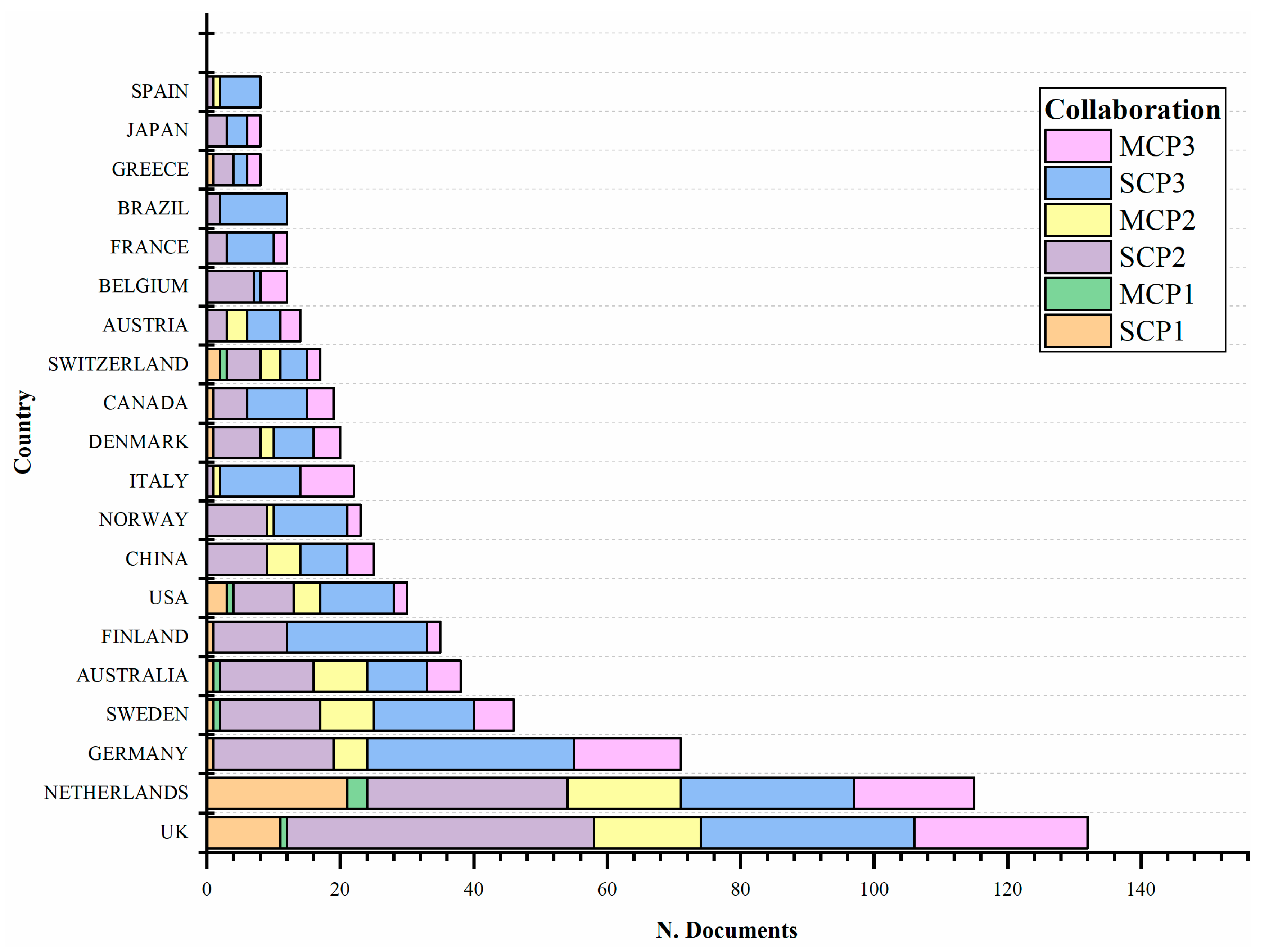
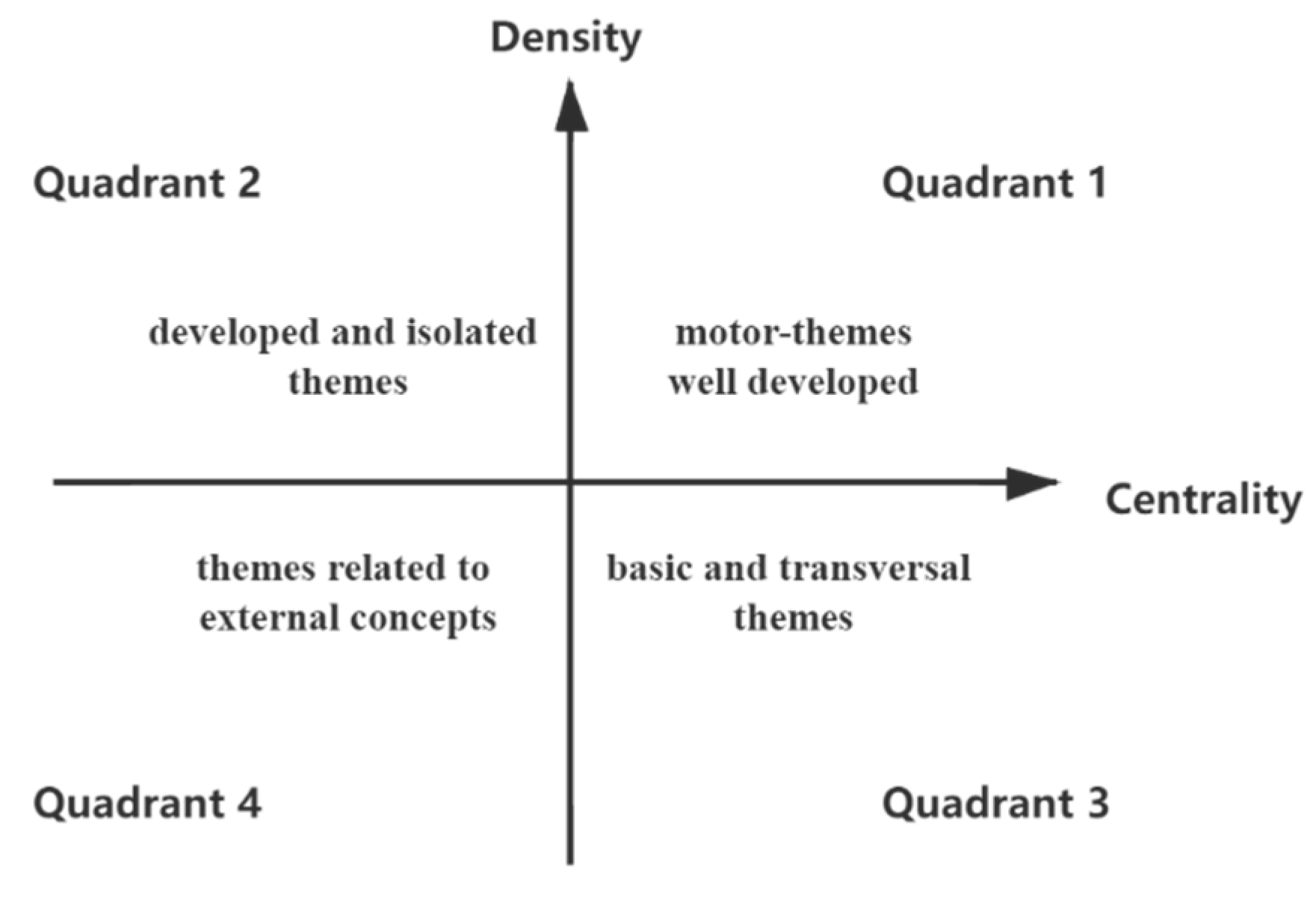
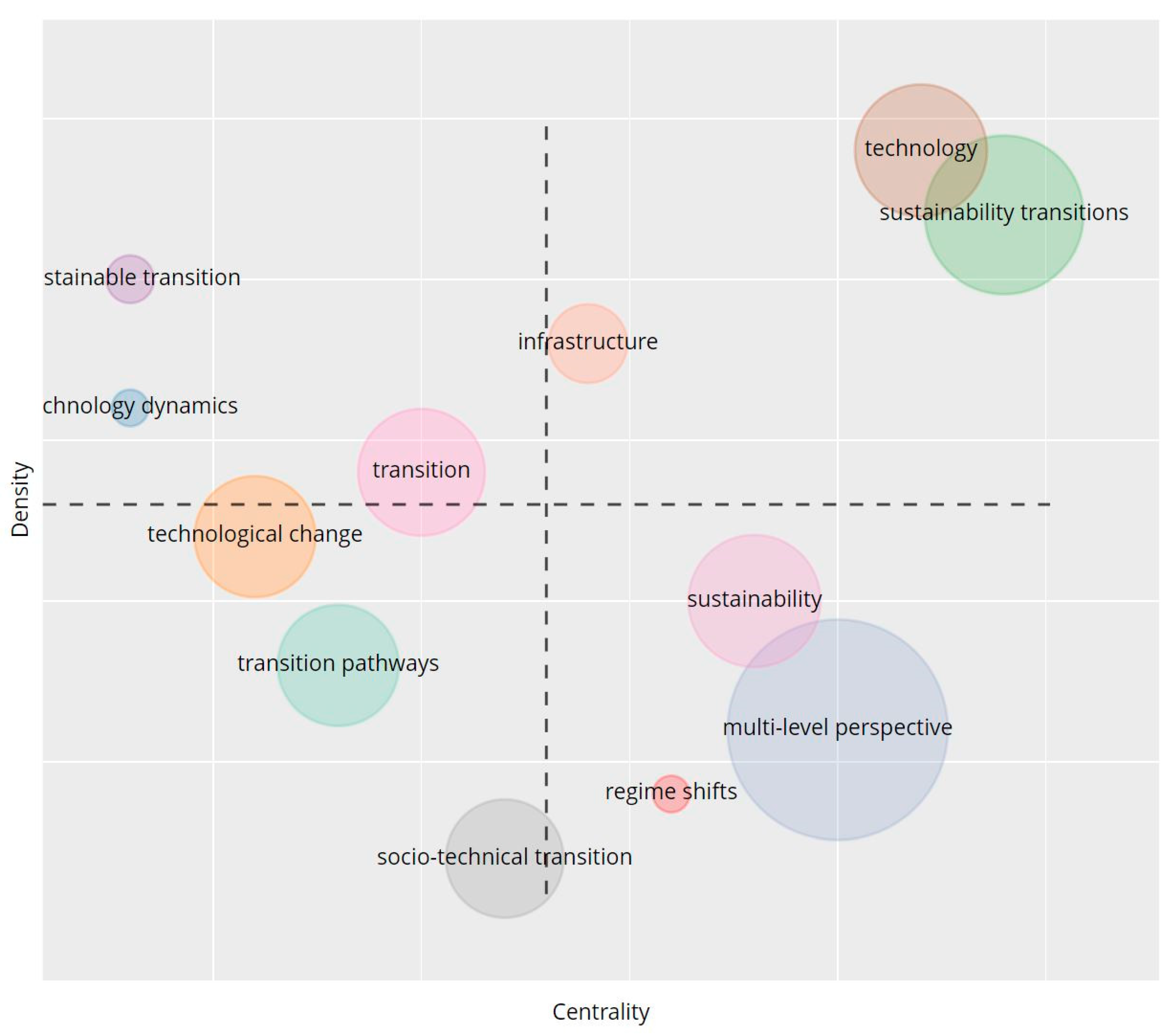

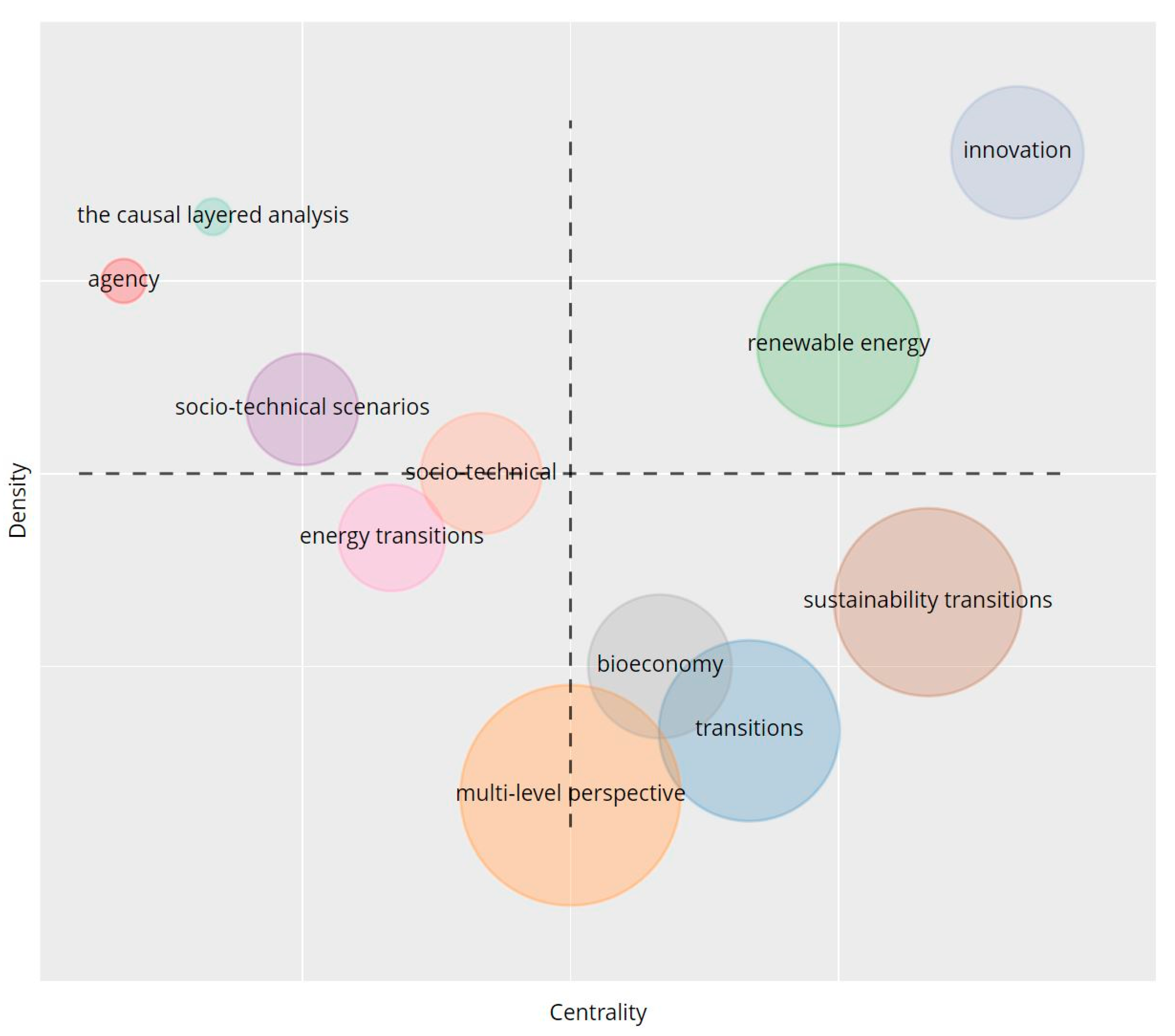
| Period 1: 2002–2011 | Period 2: 2012–2017 | Period 3: 2018–2020 | Total: 2002–2020 | |||||||
|---|---|---|---|---|---|---|---|---|---|---|
| R | Source | N | Source | N | Source | N | Source | N | H | TC |
| 1 | Research Policy | 11 | Environmental Innovation and Societal Transitions | 38 | Environmental Innovation and Societal Transitions | 41 | Environmental Innovation and Societal Transitions | 83 | 23 | 2592 |
| 2 | Technological Forecasting and Social Change | 9 | Technological Forecasting and Social Change | 22 | Sustainability | 37 | Technological Forecasting and Social Change | 67 | 23 | 2345 |
| 3 | Technology Analysis & Strategic Management | 4 | Research Policy | 21 | Technological Forecasting and Social Change | 36 | Research Policy | 55 | 32 | 11,881 |
| 4 | Technology in Society | 4 | Journal of Cleaner Production | 12 | Energy Research & Social Science | 34 | Sustainability | 48 | 10 | 395 |
| 5 | Journal of Cleaner Production | 2 | Energy Policy | 12 | Research Policy | 23 | Energy Research & Social Science | 42 | 13 | 834 |
| 6 | Environmental Innovation and Societal Transitions | 2 | Sustainability | 11 | Journal of Cleaner Production | 16 | Journal of Cleaner Production | 30 | 15 | 678 |
| 7 | Science Technology & Human Values | 2 | Renewable & Sustainable Energy Reviews | 9 | Energy Policy | 15 | Energy Policy | 27 | 14 | 663 |
| 8 | Energy Research & Social Science | 8 | Energies | 9 | Technology Analysis & Strategic Management | 17 | 10 | 1358 | ||
| 9 | Technology Analysis & Strategic Management | 8 | Environmental Science & Policy | 5 | Renewable & Sustainable Energy Reviews | 12 | 8 | 244 | ||
| 10 | European Planning Studies | 6 | Futures | 5 | Futures | 10 | 7 | 205 | ||
| 11 | Environment and Planning A-Economy and Space | 4 | Technology Analysis & Strategic Management | 5 | Energies | 9 | 3 | 18 | ||
| Rank | Period 1 | Period 2 | Period 3 | Total | |||||||||
|---|---|---|---|---|---|---|---|---|---|---|---|---|---|
| Author | N | TC | Author | N | TC | Author | N | TC | Author | N | H | TC | |
| 1 | Geels F | 18 | 9025 | Coenen L | 7 | 1027 | Geels F | 13 | 383 | Geels F | 37 | 26 | 10,665 |
| 2 | Verbong G | 6 | 497 | Truffer B | 7 | 2227 | Sovacool B | 10 | 398 | Raven R | 16 | 11 | 2366 |
| 3 | Raven R | 4 | 252 | Geels F | 6 | 1257 | Klerkx L | 9 | 161 | Sovacool B | 12 | 9 | 714 |
| 4 | Smith A | 3 | 1065 | Kivimaa P | 6 | 409 | Raven R | 6 | 160 | Hekkert M | 10 | 7 | 402 |
| 5 | Truffer B | 3 | 636 | Raven R | 6 | 1954 | Upham P | 6 | 35 | Kivimaa P | 10 | 9 | 629 |
| 6 | Bai X | 2 | 169 | Hekkert M | 5 | 370 | Hekkert M | 5 | 32 | Klerkx L | 10 | 7 | 225 |
| 7 | Foxon T | 2 | 340 | Markard J | 5 | 1463 | Hyysalo S | 5 | 219 | Truffer B | 10 | 10 | 2863 |
| 8 | Kemp R | 2 | 208 | Avelino F | 4 | 409 | Bogel P | 4 | 30 | Upham P | 10 | 6 | 104 |
| 9 | Pearson P | 2 | 196 | Chang R | 4 | 93 | Boon W | 4 | 75 | Coenen L | 9 | 8 | 1161 |
| 10 | Schot J | 2 | 2441 | Grin J | 4 | 241 | El B H | 4 | 35 | Markard J | 9 | 8 | 2138 |
| 11 | Voss J | 2 | 745 | Loorbach D | 4 | 347 | Falcone P | 4 | 76 | Verbong G | 9 | 7 | 542 |
| 12 | Wieczorek A | 2 | 169 | Nykvist B | 4 | 109 | Kivimaa P | 4 | 220 | Pearson P | 8 | 6 | 292 |
| 13 | Witkamp M | 2 | 83 | Pearson P | 4 | 92 | Matschoss K | 4 | 35 | Markard J | 7 | 6 | 601 |
| 14 | Alexander K | 1 | 24 | Upham P | 4 | 69 | Pel B | 4 | 192 | Pel B | 7 | 5 | 386 |
| 15 | Angel D | 1 | 37 | Zhao Z | 4 | 93 | Rogge K | 4 | 92 | Wells P | 7 | 5 | 285 |
| Country | Period 1 | Period 2 | Period 3 | Total | ||||
|---|---|---|---|---|---|---|---|---|
| TC | N | TC | N | TC | N | TC | N | |
| UK | 2679 | 21 | 3729 | 116 | 697 | 141 | 7105 | 278 |
| NETHERLANDS | 7974 | 37 | 2110 | 99 | 384 | 107 | 10,468 | 243 |
| GERMANY | 75 | 3 | 669 | 43 | 393 | 90 | 1137 | 136 |
| SWEDEN | 146 | 6 | 1052 | 48 | 160 | 63 | 1358 | 117 |
| AUSTRALIA | 64 | 5 | 397 | 37 | 175 | 32 | 636 | 74 |
| USA | 114 | 5 | 666 | 30 | 61 | 39 | 841 | 74 |
| FINLAND | 14 | 1 | 229 | 23 | 91 | 47 | 334 | 71 |
| CHINA a | - | - | 251 | 28 | 12 | 23 | 263 | 51 |
| ITALY | - | - | 4 | 8 | 169 | 39 | 173 | 47 |
| FRANCE | - | - | 24 | 14 | 49 | 31 | 73 | 45 |
| NORWAY | - | - | 107 | 21 | 74 | 22 | 181 | 43 |
| SWITZERLAND | 636 | 3 | 1623 | 21 | 46 | 19 | 2305 | 43 |
| SPAIN | - | - | 19 | 6 | 30 | 31 | 49 | 37 |
| DENMARK | 39 | 1 | 325 | 13 | 144 | 21 | 508 | 35 |
| CANADA | 67 | 1 | 131 | 8 | 94 | 21 | 292 | 30 |
| AUSTRIA | - | - | 490 | 9 | 40 | 17 | 530 | 26 |
| BRAZIL | - | - | 14 | 5 | 21 | 21 | 35 | 26 |
| JAPAN | - | 1 | 46 | 9 | 3 | 13 | 49 | 23 |
| BELGIUM | - | - | 172 | 12 | 3 | 10 | 175 | 22 |
| NEW ZEALAND | - | - | 29 | 10 | 46 | 9 | 75 | 19 |
| Rank | Document | Year | GC | TCY | LC | LC (%) | Source | CC |
|---|---|---|---|---|---|---|---|---|
| 1 | Technological transitions as evolutionary reconfiguration processes: a multi-level perspective and a case-study [7] | 2002 | 2154 | 102.6 | 517 | 24.00 | RES POLICY | Red |
| 2 | Typology of sociotechnical transition pathways [6] | 2007 | 1704 | 106.5 | 376 | 22.07 | RES POLICY | Red |
| 3 | From sectoral systems of innovation to socio-technical systems: Insights about dynamics and change from sociology and institutional theory [97] | 2004 | 1269 | 66.8 | 227 | 17.89 | RES POLICY | Red |
| 4 | Sustainability transitions: An emerging field of research and its prospects [2] | 2012 | 1017 | 92.5 | 206 | 20.26 | RES POLICY | Blue |
| 5 | The multi-level perspective on sustainability transitions: Responses to seven criticisms [9] | 2011 | 920 | 76.7 | 0 | 0.00 | ENVIRON INNOV SOC TR | Red |
| 6 | Strategic niche management and sustainable innovation journeys: theory, findings, research agenda, and policy [83] | 2008 | 737 | 49.1 | 158 | 21.44 | TECHNOL ANAL STRATEG | Blue |
| 7 | Innovation studies and sustainability transitions: The allure of the multi-level perspective and its challenges [12] | 2010 | 671 | 51.6 | 168 | 25.04 | RES POLICY | Green |
| 8 | What is protective space? Reconsidering niches in transitions to sustainability [80] | 2012 | 621 | 56.5 | 154 | 24.80 | RES POLICY | Green |
| 9 | Ontologies, socio-technical transitions (to sustainability), and the multi-level perspective [137] | 2010 | 605 | 46.5 | 157 | 25.95 | RES POLICY | Red |
| 10 | Technological innovation systems and the multi-level perspective: Towards an integrated framework [25] | 2008 | 510 | 34.0 | 160 | 31.37 | RES POLICY | Blue |
| 11 | Regime Resistance against Low-Carbon Transitions: Introducing Politics and Power into the Multi-Level Perspective [74] | 2014 | 457 | 50.8 | 114 | 24.95 | THEOR CULT SOC | Green |
| 12 | Toward a spatial perspective on sustainability transitions [50] | 2012 | 443 | 40.3 | 95 | 21.44 | RES POLICY | Green |
| 13 | Can cities shape socio-technical transitions and how would we know if they were [138] | 2010 | 368 | 28.3 | 65 | 17.66 | RES POLICY | Green |
| 14 | Processes and patterns in transitions and system innovations: Refining the co-evolutionary multi-level perspective [139] | 2005 | 335 | 18.6 | 93 | 27.76 | TECHNOL FORECAST SOC | Red |
| 15 | The dynamics of transitions in socio-technical systems: A multi-level analysis of the transition pathway from horse-drawn carriages to automobiles (1860–1930) [140] | 2005 | 328 | 18.2 | 93 | 28.35 | TECHNOL ANAL STRATEG | Red |
| 16 | A socio-technical analysis of low-carbon transitions: introducing the multi-level perspective into transport studies [8] | 2012 | 322 | 29.3 | 131 | 40.68 | J TRANSP GEOGR | Red |
| 17 | The Politics of Social-ecological Resilience and Sustainable Socio-technical Transitions [141] | 2010 | 306 | 23.5 | 32 | 10.46 | ECOL SOC | Green |
| 18 | Legitimizing research, technology and innovation policies for transformative change: Combining insights from innovation systems and multi-level perspective in a comprehensive ‘failures’ framework [66] | 2012 | 282 | 25.6 | 81 | 28.72 | RES POLICY | Blue |
| 19 | Environmental Innovation and Sustainability Transitions in Regional Studies [142] | 2012 | 246 | 22.4 | 33 | 13.41 | REG STUD | Green |
| 20 | Creative destruction or mere niche support? Innovation policy mixes for sustainability transitions [143] | 2016 | 240 | 34.3 | 61 | 25.42 | RES POLICY | Green |
| Period 1: 2002–2011 | Period 2: 2012–2017 | Period 3: 2018–2020 | |||
|---|---|---|---|---|---|
| DE | Frequency | DE | Frequency | DE | Frequency |
| multi-level perspective | 26 | multi-level perspective | 119 | multi-level perspective | 158 |
| transitions | 11 | transitions | 70 | sustainability transitions | 81 |
| system innovation | 8 | socio-technical transition | 43 | transitions | 61 |
| sustainability | 7 | sustainability | 41 | socio-technical transition | 53 |
| socio-technical transition | 6 | sustainability transitions | 40 | sustainability | 36 |
| strategic niche management | 5 | innovation | 24 | energy transitions | 30 |
| sustainability transitions | 5 | energy transitions | 23 | renewable energy | 24 |
| transition pathways | 5 | governance | 21 | innovation | 22 |
| innovation | 4 | strategic niche management | 20 | governance | 21 |
| sustainable development | 4 | renewable energy | 15 | innovation systems | 15 |
| technology | 4 | energy | 14 | energy | 14 |
| transition | 4 | policy | 13 | socio-technical systems | 13 |
| transition management | 4 | china | 12 | technological innovation systems | 12 |
| co-evolution | 3 | innovation systems | 11 | policy | 10 |
| patterns | 3 | dynamics | 10 | transformation | 10 |
| regime | 3 | innovation policy | 10 | agency | 9 |
| technological change | 3 | niches | 10 | strategic niche management | 9 |
| Abbreviation | Sources |
|---|---|
| ECOL ECON | Ecological Economics |
| ECOL SOC | Ecology and Society |
| ENVIRON PLANN A | Environment and Planning A-Economy and Space |
| ENVIRON PLANN C | Environment and Planning C-Government and Policy |
| ENVIRON POLIT | Environmental Politics |
| GLOBAL ENVIRON CHANG | Global Environmental Change |
| THEO CULT SOC | Theory Culture & Society |
| POLICY SCI | Policy Science |
| PROG HUM GEOG | Progress in Human Geography |
| SUSTAIN SCI | Sustainability Science |
| J ENVIR ON POL PLAN | Journal of Environmental Policy & Planning |
| TECHNOL FORECAST SOC | Technological Forecasting and Social Change |
| J CLEAN PROD | Journal of Cleaner Production |
| RES POLICY | Research Policy |
| RENEW SUST ENERG REV | Renewable & Sustainable Energy Reviews |
| ENERGY RES SOC SCI | Energy Research & Social Science |
| ENVIRON INNOV SOC TR | Environmental Innovation and Societal Transitions |
| TECHNOL ANAL STRATEG | Technology Analysis & Strategic Management |
| SUSTAINABILITY-BASEL | Sustainability |
| SCI PUBL POLICY | Science and Public Policy |
| TECHNOL SOC | Technology in Society |
| IND CORP CHANGE | Industrial and Corporate Change |
| ACAD MANAGE REV | Academy of Management Review |
| SCI TECHNOL HUM VAL | Science Technology & Human Values |
| ENVIRON SCI POLICY | Environmental Science & Policy |
| ENVIRON POLICY GOV | Environmental Policy and Governance |
| EUR PLAN STUD | European Planning Studies |
| J ENVIRON POL PLAN | Journal of Environmental Policy & Planning |
| J RURAL STUD | Journal of Rural Studies |
| AGR HUM VALUES | Agriculture and Human Values |
| TRANSPORT RES A-POL | Transportation Research Part A-Policy And Practice |
References
- Geels, F.W. Understanding system innovations: A critical literature review and a conceptual synthesis. In System Innovation and the Transition to Sustainability; Edward Elgar Publishing: Cheltenham, UK, 2004; pp. 19–47. ISBN 1843766833. [Google Scholar]
- Markard, J.; Raven, R.; Truffer, B. Sustainability transitions: An emerging field of research and its prospects. Res. Policy 2012, 41, 955–967. [Google Scholar] [CrossRef]
- Thacker, S.; Adshead, D.; Fay, M.; Hallegatte, S.; Harvey, M.; Meller, H.; O’Regan, N.; Rozenberg, J.; Watkins, G.; Hall, J.W. Infrastructure for sustainable development. Nat. Sustain. 2019, 2, 324–331. [Google Scholar] [CrossRef]
- Lachman, D.A. A survey and review of approaches to study transitions. Energy Policy 2013, 58, 269–276. [Google Scholar] [CrossRef]
- Rip, A.; Kemp, R. Technological change. In Human Choice and Climate Change; Rayner, S., Malone, E.L., Eds.; Battelle Press: Columbus, OH, USA, 1998; pp. 327–339. [Google Scholar]
- Geels, F.W.; Schot, J. Typology of sociotechnical transition pathways. Res. Policy 2007, 36, 399–417. [Google Scholar] [CrossRef]
- Geels, F.W. Technological transitions as evolutionary reconfiguration processes: A multi-level perspective and a case-study. Res. Policy 2002, 31, 1257–1274. [Google Scholar] [CrossRef] [Green Version]
- Geels, F.W. A socio-technical analysis of low-carbon transitions: Introducing the multi-level perspective into transport studies. J. Transp. Geogr. 2012, 24, 471–482. [Google Scholar] [CrossRef]
- Geels, F.W. The multi-level perspective on sustainability transitions: Responses to seven criticisms. Environ. Innov. Soc. Transitions 2011, 1, 24–40. [Google Scholar] [CrossRef]
- Schot, J. The usefulness of evolutionary models for explaining innovation. The case of the Netherlands in the nineteenth century. Hist. Technol. 1998, 14, 173–200. [Google Scholar] [CrossRef]
- Nelson, R.R.; Winter, S.G. An Evolutionary Theory of Economic Change; Belknap Press: Cambridge, MA, USA, 1982. [Google Scholar]
- Smith, A.; Voss, J.P.; Grin, J. Innovation studies and sustainability transitions: The allure of the multi-level perspective and its challenges. Res. Policy 2010, 39, 435–448. [Google Scholar] [CrossRef]
- Geels, F.W. Co-evolutionary and multi-level dynamics in transitions: The transformation of aviation systems and the shift from propeller to turbojet (1930–1970). Technovation 2006, 26, 999–1016. [Google Scholar] [CrossRef]
- Geels, F.W. Socio-technical transitions to sustainability: A review of criticisms and elaborations of the Multi-Level Perspective. Curr. Opin. Environ. Sustain. 2019, 39, 187–201. [Google Scholar] [CrossRef]
- El Bilali, H. The multi-level perspective in research on sustainability transitions in agriculture and food systems: A systematic review. Agriculture 2019, 9, 74. [Google Scholar] [CrossRef] [Green Version]
- Carroli, L. Planning roles in infrastructure system transitions: A review of research bridging socio-technical transitions and planning. Environ. Innov. Soc. Transit. 2018, 29, 81–89. [Google Scholar] [CrossRef]
- Linnenluecke, M.K.; Marrone, M.; Singh, A.K. Conducting systematic literature reviews and bibliometric analyses. Aust. J. Manag. 2020, 45, 175–194. [Google Scholar] [CrossRef]
- Fischer, L.B.; Newig, J. Importance of actors and agency in sustainability transitions: A systematic exploration of the literature. Sustainability 2016, 8, 476. [Google Scholar] [CrossRef] [Green Version]
- Martínez Arranz, A. Lessons from the past for sustainability transitions? A meta-analysis of socio-technical studies. Glob. Environ. Change 2017, 44, 125–143. [Google Scholar] [CrossRef]
- Wang, C.; Lv, T.; Deng, X. Bibliometric and Visualized Analysis of China’s Smart Grid Research. Front. Res. Metrics Anal. 2020, 5, 1–21. [Google Scholar] [CrossRef]
- Aria, M.; Cuccurullo, C. bibliometrix: An R-tool for comprehensive science mapping analysis. J. Informetr. 2017, 11, 959–975. [Google Scholar] [CrossRef]
- van Eck, N.J.; Waltman, L. Software survey: VOSviewer, a computer program for bibliometric mapping. Scientometrics 2010, 84, 523–538. [Google Scholar] [CrossRef] [PubMed] [Green Version]
- Geels, F.W. Join the sustainability transitions research network (STRN). Environ. Innov. Soc. Transit. 2011, 1, 192–194. [Google Scholar] [CrossRef]
- Geels, F.W.; Sovacool, B.K.; Schwanen, T.; Sorrell, S. The Socio-Technical Dynamics of Low-Carbon Transitions. Joule 2017, 1, 463–479. [Google Scholar] [CrossRef] [Green Version]
- Markard, J.; Truffer, B. Technological innovation systems and the multi-level perspective: Towards an integrated framework. Res. Policy 2008, 37, 596–615. [Google Scholar] [CrossRef]
- Genus, A.; Coles, A.M. Rethinking the multi-level perspective of technological transitions. Res. Policy 2008, 37, 1436–1445. [Google Scholar] [CrossRef]
- Smith, A.; Stirling, A.; Berkhout, F. The governance of sustainable socio-technical transitions. Res. Policy 2005, 34, 1491–1510. [Google Scholar] [CrossRef]
- Gillard, R.; Gouldson, A.; Paavola, J.; Van Alstine, J. Transformational responses to climate change: Beyond a systems perspective of social change in mitigation and adaptation. WIREs Clim. Change 2016, 7, 251–265. [Google Scholar] [CrossRef]
- Berkhout, F.; Smith, A.; Stirling, A. Socio-technological regimes and transition contexts. In System Innovation and the Transition to Sustainability; Elzen, B., Geels, F., Green, K., Eds.; Edward Elgar Publishing: Northampton, MA, USA, 2004; pp. 48–75. ISBN 1843766833. [Google Scholar]
- Shove, E.; Walker, G. Caution! Transitions Ahead: Politics, Practice, and Sustainable Transition Management. Environ. Plan. A Econ. Sp. 2007, 39, 763–770. [Google Scholar] [CrossRef] [Green Version]
- Geels, F.W. Analysing the breakthrough of rock ‘n’ roll (1930–1970) Multi-regime interaction and reconfiguration in the multi-level perspective. Technol. Forecast. Soc. Change 2007, 74, 1411–1431. [Google Scholar] [CrossRef]
- McDowall, W.; Geels, F.W. Ten challenges for computer models in transitions research: Commentary on Holtz et al. Environ. Innov. Soc. Transit. 2017, 22, 41–49. [Google Scholar] [CrossRef]
- Turnheim, B.; Berkhout, F.; Geels, F.W.; Hof, A.; McMeekin, A.; Nykvist, B.; van Vuuren, D. Evaluating sustainability transitions pathways: Bridging analytical approaches to address governance challenges. Glob. Environ. Change 2015, 35, 239–253. [Google Scholar] [CrossRef] [Green Version]
- Köhler, J.; Turnheim, B.; Hodson, M. Low carbon transitions pathways in mobility: Applying the MLP in a combined case study and simulation bridging analysis of passenger transport in the Netherlands. Technol. Forecast. Soc. Change 2020, 151, 119314. [Google Scholar] [CrossRef] [Green Version]
- Geels; Berkhout, F.; Van Vuuren, D.P. Bridging analytical approaches for low-carbon transitions. Nat. Clim. Change 2016, 6, 576–583. [Google Scholar] [CrossRef] [Green Version]
- van Sluisveld, M.A.E.; Hof, A.F.; Carrara, S.; Geels, F.W.; Nilsson, M.; Rogge, K.; Turnheim, B.; van Vuuren, D.P. Aligning integrated assessment modelling with socio-technical transition insights: An application to low-carbon energy scenario analysis in Europe. Technol. Forecast. Soc. Change 2020, 151, 119177. [Google Scholar] [CrossRef] [Green Version]
- Hof, A.F.; Carrara, S.; De Cian, E.; Pfluger, B.; van Sluisveld, M.A.E.; de Boer, H.S.; van Vuuren, D.P. From global to national scenarios: Bridging different models to explore power generation decarbonisation based on insights from socio-technical transition case studies. Technol. Forecast. Soc. Change 2020, 151, 119882. [Google Scholar] [CrossRef]
- Zwartkruis, J.V.; Berg, H.; Hof, A.F.; Kok, M.T.J. Agricultural nature conservation in the Netherlands: Three lenses on transition pathways. Technol. Forecast. Soc. Change 2020, 151, 119235. [Google Scholar] [CrossRef]
- Geels, F.W.; McMeekin, A.; Pfluger, B. Socio-technical scenarios as a methodological tool to explore social and political feasibility in low-carbon transitions: Bridging computer models and the multi-level perspective in UK electricity generation (2010–2050). Technol. Forecast. Soc. Change 2020, 151, 119258. [Google Scholar] [CrossRef]
- Rogge, K.S.; Pfluger, B.; Geels, F.W. Transformative policy mixes in socio-technical scenarios: The case of the low-carbon transition of the German electricity system (2010–2050). Technol. Forecast. Soc. Change 2020, 151, 119259. [Google Scholar] [CrossRef]
- De Cian, E.; Dasgupta, S.; Hof, A.F.; van Sluisveld, M.A.E.; Köhler, J.; Pfluger, B.; van Vuuren, D.P. Actors, decision-making, and institutions in quantitative system modelling. Technol. Forecast. Soc. Change 2020, 151, 119480. [Google Scholar] [CrossRef] [Green Version]
- Wigboldus, S.; Klerkx, L.; Leeuwis, C.; Schut, M.; Muilerman, S.; Jochemsen, H. Systemic perspectives on scaling agricultural innovations. A review. Agron. Sustain. Dev. 2016, 36, 20. [Google Scholar] [CrossRef] [Green Version]
- Wainstein, M.E.; Bumpus, A.G. Business models as drivers of the low carbon power system transition: A multi-level perspective. J. Clean. Prod. 2016, 126, 572–585. [Google Scholar] [CrossRef]
- Maassen, A. Heterogeneity of Lock-In and the Role of Strategic Technological Interventions in Urban Infrastructural Transformations. Eur. Plan. Stud. 2012, 20, 441–460. [Google Scholar] [CrossRef]
- Levidow, L.; Upham, P. Linking the multi-level perspective with social representations theory: Gasifiers as a niche innovation reinforcing the energy-from-waste (EfW) regime. Technol. Forecast. Soc. Change 2017, 120, 1–13. [Google Scholar] [CrossRef]
- Papachristos, G. A mechanism based transition research methodology: Bridging analytical approaches. Futures 2018, 98, 57–71. [Google Scholar] [CrossRef]
- Meelen, T.; Frenken, K.; Hobrink, S. Weak spots for car-sharing in The Netherlands? The geography of socio-technical regimes and the adoption of niche innovations. Energy Res. Soc. Sci. 2019, 52, 132–143. [Google Scholar] [CrossRef]
- Gibbs, D.; O’Neill, K. The Green Economy, Sustainability Transitions And Transition Regions: A Case Study Of Boston. Geogr. Ann. Ser. B-Human Geogr. 2014, 96, 201–216. [Google Scholar] [CrossRef]
- Hansen, T.; Coenen, L. The geography of sustainability transitions: Review, synthesis and reflections on an emergent research field. Environ. Innov. Soc. Transit. 2015, 17, 92–109. [Google Scholar] [CrossRef] [Green Version]
- Coenen, L.; Benneworth, P.; Truffer, B. Toward a spatial perspective on sustainability transitions. Res. Policy 2012, 41, 968–979. [Google Scholar] [CrossRef]
- Lawhon, M.; Murphy, J.T. Socio-technical regimes and sustainability transitions: Insights from political ecology. Prog. Hum. Geogr. 2011, 36, 354–378. [Google Scholar] [CrossRef]
- Raven, R.; Schot, J.; Berkhout, F. Space and scale in socio-technical transitions. Environ. Innov. Soc. Transit. 2012, 4, 63–78. [Google Scholar] [CrossRef]
- Boschma, R.; Coenen, L.; Frenken, K.; Truffer, B. Towards a theory of regional diversification: Combining insights from Evolutionary Economic Geography and Transition Studies. Reg. Stud. 2017, 51, 31–45. [Google Scholar] [CrossRef]
- Schot, J.; Kanger, L.; Verbong, G. The roles of users in shaping transitions to new energy systems. Nat. Energy 2016, 1, 16054. [Google Scholar] [CrossRef] [Green Version]
- Diaz, M.; Darnhofer, I.; Darrot, C.; Beuret, J.-E. Green tides in Brittany: What can we learn about niche–regime interactions? Environ. Innov. Soc. Transit. 2013, 8, 62–75. [Google Scholar] [CrossRef]
- Fuenfschilling, L.; Truffer, B. The interplay of institutions, actors and technologies in socio-technical systems—An analysis of transformations in the Australian urban water sector. Technol. Forecast. Soc. Change 2016, 103, 298–312. [Google Scholar] [CrossRef]
- Kivimaa, P. Government-affiliated intermediary organisations as actors in system-level transitions. Res. Policy 2014, 43, 1370–1380. [Google Scholar] [CrossRef]
- Smink, M.; Negro, S.O.; Niesten, E.; Hekkert, M.P. How mismatching institutional logics hinder niche–regime interaction and how boundary spanners intervene. Technol. Forecast. Soc. Change 2015, 100, 225–237. [Google Scholar] [CrossRef] [Green Version]
- Kivimaa, P.; Boon, W.; Hyysalo, S.; Klerkx, L. Towards a typology of intermediaries in sustainability transitions: A systematic review and a research agenda. Res. Policy 2019, 48, 1062–1075. [Google Scholar] [CrossRef]
- Smink, M.M.; Hekkert, M.P.; Negro, S.O. Keeping sustainable innovation on a leash? Exploring incumbents’ institutional strategies. Bus. Strateg. Environ. 2015, 24, 86–101. [Google Scholar] [CrossRef] [Green Version]
- Bergek, A.; Berggren, C.; Magnusson, T.; Hobday, M. Technological discontinuities and the challenge for incumbent firms: Destruction, disruption or creative accumulation? Res. Policy 2013, 42, 1210–1224. [Google Scholar] [CrossRef] [Green Version]
- Berggren, C.; Magnusson, T.; Sushandoyo, D. Transition pathways revisited: Established firms as multi-level actors in the heavy vehicle industry. Res. Policy 2015, 44, 1017–1028. [Google Scholar] [CrossRef] [Green Version]
- Penna, C.C.R.; Geels, F.W. Climate change and the slow reorientation of the American car industry (1979-2012): An application and extension of the Dialectic Issue LifeCycle (DILC) model. Res. Policy 2015, 44, 1029–1048. [Google Scholar] [CrossRef]
- Hess, D.J. Industrial fields and countervailing power: The transformation of distributed solar energy in the United States. Glob. Environ. Change 2013, 23, 847–855. [Google Scholar] [CrossRef]
- Patterson, J.; Schulz, K.; Vervoort, J.; van der Hel, S.; Widerberg, O.; Adler, C.; Hurlbert, M.; Anderton, K.; Sethi, M.; Barau, A. Exploring the governance and politics of transformations towards sustainability. Environ. Innov. Soc. Transit. 2017, 24, 1–16. [Google Scholar] [CrossRef] [Green Version]
- Weber, K.M.; Rohracher, H. Legitimizing research, technology and innovation policies for transformative change Combining insights from innovation systems and multi-level perspective in a comprehensive “failures” framework. Res. Policy 2012, 41, 1037–1047. [Google Scholar] [CrossRef]
- Grin, J.; Rotmans, J.; Schot, J. Transitions to Sustainable Development: New Directions in the Study of Long Term Transformative Change; Routledge Taylor & Francis Group: Abingdon, UK, 2010; ISBN 0203856597. [Google Scholar]
- Avelino, F.; Rotmans, J. Power in Transition: An Interdisciplinary Framework to Study Power in Relation to Structural Change. Eur. J. Soc. Theory 2009, 12, 543–569. [Google Scholar] [CrossRef] [Green Version]
- Roberts, C.; Geels, F.W. Conditions for politically accelerated transitions: Historical institutionalism, the multi-level perspective, and two historical case studies in transport and agriculture. Technol. Forecast. Soc. Change 2019, 140, 221–240. [Google Scholar] [CrossRef]
- Roberts, C.; Geels, F.W. Conditions and intervention strategies for the deliberate acceleration of socio-technical transitions: Lessons from a comparative multi-level analysis of two historical case studies in Dutch and Danish heating. Technol. Anal. Strateg. Manag. 2019, 31, 1081–1103. [Google Scholar] [CrossRef]
- Kanger, L.; Sovacool, B.K.; Noorkõiv, M. Six policy intervention points for sustainability transitions: A conceptual framework and a systematic literature review. Res. Policy 2020, 49, 104072. [Google Scholar] [CrossRef]
- Hess, D.J. The politics of niche-regime conflicts: Distributed solar energy in the United States. Environ. Innov. Soc. Transit. 2016, 19, 42–50. [Google Scholar] [CrossRef] [Green Version]
- Markard, J.; Suter, M.; Ingold, K. Socio-technical transitions and policy change—Advocacy coalitions in Swiss energy policy. Environ. Innov. Soc. Transit. 2016, 18, 215–237. [Google Scholar] [CrossRef] [Green Version]
- Geels, F.W. Regime Resistance against Low-Carbon Transitions: Introducing Politics and Power into the Multi-Level Perspective. Theory Cult. Soc. 2014, 31, 21–40. [Google Scholar] [CrossRef] [Green Version]
- Kern, F.; Markard, J. Analysing Energy Transitions: Combining Insights from Transition Studies and International Political Economy. In The Palgrave Handbook of the International Political Economy of Energy; Van de Graaf, T., Sovacool, B.K., Ghosh, A., Kern, F., Klare, M.T., Eds.; Palgrave Macmillan: London, UK, 2016; pp. 291–318. ISBN 978-1-137-55631-8. [Google Scholar]
- Hess, D.J. Sustainability transitions: A political coalition perspective. Res. Policy 2014, 43, 278–283. [Google Scholar] [CrossRef] [Green Version]
- Fuenfschilling, L.; Truffer, B. The structuration of socio-technical regimes-Conceptual foundations from institutional theory. Res. Policy 2014, 43, 772–791. [Google Scholar] [CrossRef]
- Elzen, B.; Geels, F.W.; Leeuwis, C.; van Mierlo, B. Normative contestation in transitions ‘in the making’: Animal welfare concerns and system innovation in pig husbandry. Res. Policy 2011, 40, 263–275. [Google Scholar] [CrossRef]
- Kanger, L. Rethinking the Multi-level Perspective for energy transitions: From regime life-cycle to explanatory typology of transition pathways. Energy Res. Soc. Sci. 2021, 71, 101829. [Google Scholar] [CrossRef]
- Smith, A.; Raven, R. What is protective space? Reconsidering niches in transitions to sustainability. Res. Policy 2012, 41, 1025–1036. [Google Scholar] [CrossRef] [Green Version]
- Geels, F.W. Reconceptualising the co-evolution of firms-in-industries and their environments: Developing an inter-disciplinary Triple Embeddedness Framework. Res. Policy 2014, 43, 261–277. [Google Scholar] [CrossRef]
- Raven, R.; Kern, F.; Verhees, B.; Smith, A. Niche construction and empowerment through socio-political work. A meta-analysis of six low-carbon technology cases. Environ. Innov. Soc. Transit. 2016, 18, 164–180. [Google Scholar] [CrossRef] [Green Version]
- Schot, J.; Geels, F.W. Strategic niche management and sustainable innovation journeys: Theory, findings, research agenda, and policy. Technol. Anal. Strateg. Manag. 2008, 20, 537–554. [Google Scholar] [CrossRef]
- Coombs, R.; Green, K.; Richards, A.; Walsh, V. Technology and the Market Demand, Users and Innovation; Edward Elgar Publishing: Cheltenham, UK, 2001; ISBN 9781840644692. [Google Scholar]
- Geels, F.W.; Raven, R. Non-linearity and expectations in niche-development trajectories: Ups and downs in Dutch biogas development (1973–2003). Technol. Anal. Strateg. Manag. 2006, 18, 375–392. [Google Scholar] [CrossRef]
- Schot, J.; Geels, F.W. Niches in evolutionary theories of technical change. J. Evol. Econ. 2007, 17, 605–622. [Google Scholar] [CrossRef] [Green Version]
- Nelson, R.R.; Winter, S.G. In search of useful theory of innovation. Res. Policy 1977, 6, 36–76. [Google Scholar] [CrossRef]
- Kemp, R.; Schot, J.; Hoogma, R. Regime shifts to sustainability through processes of niche formation: The approach of strategic niche management. Technol. Anal. Strateg. Manag. 1998, 10, 175–198. [Google Scholar] [CrossRef]
- Kemp, R.P.M.; Rip, A.; Schot, J. Constructing Transition Paths through the Management of Niches. In Path Dependence and Creation, Lawrence Erlbaum; Garud, R., Karnoe, P., Eds.; Psychology Press: New York, NY, USA, 2001; pp. 269–299. [Google Scholar]
- Geels, F.W. Major system change through stepwise reconfiguration: A multi-level analysis of the transformation of American factory production (1850–1930). Technol. Soc. 2006, 28, 445–476. [Google Scholar] [CrossRef]
- Holtz, G.; Brugnach, M.; Pahl-Wostl, C. Specifying “regime”—A framework for defining and describing regimes in transition research. Technol. Forecast. Soc. Change 2008, 75, 623–643. [Google Scholar] [CrossRef]
- Turnheim, B.; Geels, F.W. Regime destabilisation as the flipside of energy transitions: Lessons from the history of the British coal industry (1913–1997). Energy Policy 2012, 50, 35–49. [Google Scholar] [CrossRef]
- Turnheim, B.; Geels, F.W. The destabilisation of existing regimes: Confronting a multi-dimensional framework with a case study of the British coal industry (1913–1967). Res. Policy 2013, 42, 1749–1767. [Google Scholar] [CrossRef]
- Konrad, K.; Truffer, B.; Voss, J.P. Multi-regime dynamics in the analysis of sectoral transformation potentials: Evidence from German utility sectors. J. Clean. Prod. 2008, 16, 1190–1202. [Google Scholar] [CrossRef]
- Suarez, F.F.; Oliva, R. Environmental change and organizational transformation. Ind. Corp. Change 2005, 14, 1017–1041. [Google Scholar] [CrossRef] [Green Version]
- Jan, R.; René, K.; van Marjolein, A. More evolution than revolution: Transition management in public policy. Foresight 2001, 3, 15–31. [Google Scholar] [CrossRef]
- Geels, F.W. From sectoral systems of innovation to socio-technical systems: Insights about dynamics and change from sociology and institutional theory. Res. Policy 2004, 33, 897–920. [Google Scholar] [CrossRef]
- Latour, B. Science in Action: How to Follow Scientists and Engineers through Society; Harvard University Press: Cambridge, MA, USA, 1987; ISBN 9780674792913. [Google Scholar]
- Van De Poel, I. On the Role of Outsiders in Technical Development. Technol. Anal. Strateg. Manag. 2000, 12, 383–397. [Google Scholar] [CrossRef]
- van de Poel, I. The transformation of technological regimes. Res. Policy 2003, 32, 49–68. [Google Scholar] [CrossRef]
- Carlsson, B.; Stankiewicz, R. On the nature, function and composition of technological systems. J. Evol. Econ. 1991, 1, 93–118. [Google Scholar] [CrossRef]
- Rammert, W. New rules of sociological method: Rethinking technology studies. Br. J. Sociol. 1997, 48, 171–191. [Google Scholar] [CrossRef]
- Geels, F.W. The hygienic transition from cesspools to sewer systems (1840–1930): The dynamics of regime transformation. Res. Policy 2006, 35, 1069–1082. [Google Scholar] [CrossRef]
- Dosi, G.; Freeman, C.; Nelson, R.; Silverberg, G.; Soete, L. Structural crisis of adjustment, business cycles and investment behaviour. In Technical Change and Economic Theory; Dosi, G., Freeman, C., Nelson, R., Silverberg, G., Soete, L., Eds.; Sant‘Anna School of Advanced Studies: Pisa, Italy, 1988; pp. 38–66. ISBN 0861878949. [Google Scholar]
- Douthwaite, B.; Keatinge, J.D.H.; Park, J.R. Learning selection: An evolutionary model for understanding, implementing and evaluating participatory technology development. Agric. Syst. 2002, 72, 109–131. [Google Scholar] [CrossRef]
- Geels, F.W.; Raven, R. Socio-cognitive evolution and co-evolution in competing technical trajectories: Biogas development Denmark (1970-2002). Int. J. Sustain. Dev. World Ecol. 2007, 14, 63–77. [Google Scholar] [CrossRef]
- Braudel, F. The Mediterranean and the Mediterranean World in the Age of Philip II; Harper & Row: New York, NY, USA, 1976. [Google Scholar]
- Bergek, A.; Hekkert, M.; Jacobsson, S.; Markard, J.; Sandén, B.; Truffer, B. Technological innovation systems in contexts: Conceptualizing contextual structures and interaction dynamics. Environ. Innov. Soc. Transit. 2015, 16, 51–64. [Google Scholar] [CrossRef] [Green Version]
- Bergek, A.; Jacobsson, S.; Carlsson, B.; Lindmark, S.; Rickne, A. Analyzing the functional dynamics of technological innovation systems: A scheme of analysis. Res. Policy 2008, 37, 407–429. [Google Scholar] [CrossRef] [Green Version]
- Rotmans, J.; Loorbach, D. Complexity and Transition Management. J. Ind. Ecol. 2009, 13, 184–196. [Google Scholar] [CrossRef] [Green Version]
- Kemp, R.; Loorbach, D.; Rotmans, J. Transition management as a model for managing processes of co-evolution towards sustainable development. Int. J. Sustain. Dev. World Ecol. 2007, 14, 78–91. [Google Scholar] [CrossRef] [Green Version]
- Loorbach, D. Transition management for sustainable development: A Prescriptive, complexity-based governance framework. Governance 2010, 23, 161–183. [Google Scholar] [CrossRef]
- Callon, M.; Courtial, J.P.; Laville, F. Co-word analysis as a tool for describing the network of interactions between basic and technological research: The case of polymer chemsitry. Scientometrics 1991, 22, 155–205. [Google Scholar] [CrossRef]
- Schöggl, J.; Stumpf, L.; Baumgartner, R.J. Resources, Conservation & Recycling The narrative of sustainability and circular economy—A longitudinal review of two decades of research. Resour. Conserv. Recycl. 2020, 163, 105073. [Google Scholar] [CrossRef]
- Osunmuyiwa, O.; Biermann, F.; Kalfagianni, A. Applying the multi-level perspective on socio-technical transitions torentier states: The case of renewable energy transitions in Nigeria. J. Environ. Policy Plan. 2018, 20, 143–156. [Google Scholar] [CrossRef]
- Belz, F.-M. A Transition Towards Sustainability in the Swiss Agri-Food Chain (1970–2000): Using and Improving the Multi-Level Perspective; Edward Elgar Publishing: Cheltenham, UK, 2004; ISBN 9781843766834. [Google Scholar]
- Verbong, G.P.J.; Geels, F.W. Exploring sustainability transitions in the electricity sector with socio-technical pathways. Technol. Forecast. Soc. Change 2010, 77, 1214–1221. [Google Scholar] [CrossRef]
- Foxon, T.J.; Hammond, G.P.; Pearson, P.J.G. Developing transition pathways for a low carbon electricity system in the UK. Technol. Forecast. Soc. Change 2010, 77, 1203–1213. [Google Scholar] [CrossRef] [Green Version]
- Augenstein, K. Analysing the potential for sustainable e-mobility—The case of Germany. Environ. Innov. Soc. Transit. 2015, 14, 101–115. [Google Scholar] [CrossRef] [Green Version]
- Cherp, A.; Vinichenko, V.; Jewell, J.; Brutschin, E.; Sovacool, B. Integrating techno-economic, socio-technical and political perspectives on national energy transitions: A meta-theoretical framework. Energy Res. Soc. Sci. 2018, 37, 175–190. [Google Scholar] [CrossRef]
- Essletzbichler, J. Renewable Energy Technology and Path Creation: A Multi-scalar Approach to Energy Transition in the UK. Eur. Plan. Stud. 2012, 20, 791–816. [Google Scholar] [CrossRef]
- Murphy, J.; Smith, A. Understanding Transition—Periphery Dynamics: Renewable Energy in the Highlands and Islands of Scotland. Environ. Plan. A Econ. Space 2013, 45, 691–709. [Google Scholar] [CrossRef] [Green Version]
- Di Lucia, L.; Ericsson, K. Low-carbon district heating in Sweden—Examining a successful energy transition. Energy Res. Soc. Sci. 2014, 4, 10–20. [Google Scholar] [CrossRef] [Green Version]
- Kern, F.; Kuzemko, C.; Mitchell, C. Measuring and explaining policy paradigm change: The case of UK energy policy. Policy Polit. 2014, 42, 513–530. [Google Scholar] [CrossRef]
- Schneidewind, U.; Augenstein, K. Analyzing a transition to a sustainability-oriented science system in Germany. Environ. Innov. Soc. Transit. 2012, 3, 16–28. [Google Scholar] [CrossRef] [Green Version]
- Späth, P.; Rohracher, H.; Von Radecki, A. Incumbent actors as niche agents: The German car industry and the taming of the “Stuttgart E-Mobility Region”. Sustainability 2016, 8, 252. [Google Scholar] [CrossRef] [Green Version]
- Reichardt, K.; Negro, S.O.; Rogge, K.S.; Hekkert, M.P. Analyzing interdependencies between policy mixes and technological innovation systems: The case of offshore wind in Germany. Technol. Forecast. Soc. Change 2016, 106, 11–21. [Google Scholar] [CrossRef] [Green Version]
- Leipprand, A.; Flachsland, C. Regime destabilization in energy transitions: The German debate on the future of coal. Energy Res. Soc. Sci. 2018, 40, 190–204. [Google Scholar] [CrossRef]
- Butlin, J. Our common future. By World commission on environment and development. (London, Oxford University Press, 1987, pp.383 £5.95.). J. Int. Dev. 1989, 1, 284–287. [Google Scholar] [CrossRef]
- Ruggerio, C.A. Sustainability and sustainable development: A review of principles and definitions. Sci. Total Environ. 2021, 786, 147481. [Google Scholar] [CrossRef]
- Li, L.; Msaad, H.; Sun, H.; Tan, M.X.; Lu, Y.; Lau, A.K.W. Green innovation and business sustainability: New evidence from energy intensive industry in China. Int. J. Environ. Res. Public Health 2020, 17, 7826. [Google Scholar] [CrossRef] [PubMed]
- Cao, S.; Nie, L.; Sun, H.; Sun, W.; Taghizadeh-Hesary, F. Digital finance, green technological innovation and energy-environmental performance: Evidence from China’s regional economies. J. Clean. Prod. 2021, 327, 129458. [Google Scholar] [CrossRef]
- Meseguer-Sánchez, V.; Gálvez-Sánchez, F.J.; Molina-Moreno, V.; Wandosell-Fernández-de-Bobadilla, G. The Main Research Characteristics of the Development of the Concept of the Circular Economy Concept: A Global Analysis and the Future Agenda. Front. Environ. Sci. 2021, 9, 1–16. [Google Scholar] [CrossRef]
- Rodríguez, R.M.; Labella, Á.; Nuñez-Cacho, P.; Molina-Moreno, V.; Martínez, L. A comprehensive minimum cost consensus model for large scale group decision making for circular economy measurement. Technol. Forecast. Soc. Change 2022, 175, 121391. [Google Scholar] [CrossRef]
- Neacșa, A.; Panait, M.; Mureșan, J.D.; Voica, M.C.; Manta, O. The Energy Transition between Desideratum and Challenge: Are Cogeneration and Trigeneration the Best Solution? Int. J. Environ. Res. Public Health 2022, 19, 3039. [Google Scholar] [CrossRef]
- Hafner, S.; Anger-Kraavi, A.; Monasterolo, I.; Jones, A. Emergence of New economics energy transition models: A review. Ecol. Econ. 2020, 177, 106779. [Google Scholar] [CrossRef]
- Geels, F.W. Ontologies, socio-technical transitions (to sustainability), and the multi-level perspective. Res. Policy 2010, 39, 495–510. [Google Scholar] [CrossRef]
- Hodson, M.; Marvin, S. Can cities shape socio-technical transitions and how would we know if they were? Res. Policy 2010, 39, 477–485. [Google Scholar] [CrossRef]
- Geels, F.W. Processes and patterns in transitions and system innovations: Refining the co-evolutionary multi-level perspective. Technol. Forecast. Soc. Change 2005, 72, 681–696. [Google Scholar] [CrossRef]
- Geels, F.W. The dynamics of transitions in socio-technical systems: A multi-level analysis of the transition pathway from horse-drawn carriages to automobiles (1860–1930). Technol. Anal. Strateg. Manag. 2005, 17, 445–476. [Google Scholar] [CrossRef]
- Smith, A.; Stirling, A. The Politics of social-ecological resilience and sustainable socio-technical transitions. Ecol. Soc. 2010, 15. [Google Scholar] [CrossRef]
- Truffer, B.; Coenen, L. Environmental Innovation and sustainability transitions in regional studies. Reg. Stud. 2012, 46, 1–21. [Google Scholar] [CrossRef]
- Kivimaa, P.; Kern, F. Creative destruction or mere niche support? Innovation policy mixes for sustainability transitions. Res. Policy 2016, 45, 205–217. [Google Scholar] [CrossRef] [Green Version]
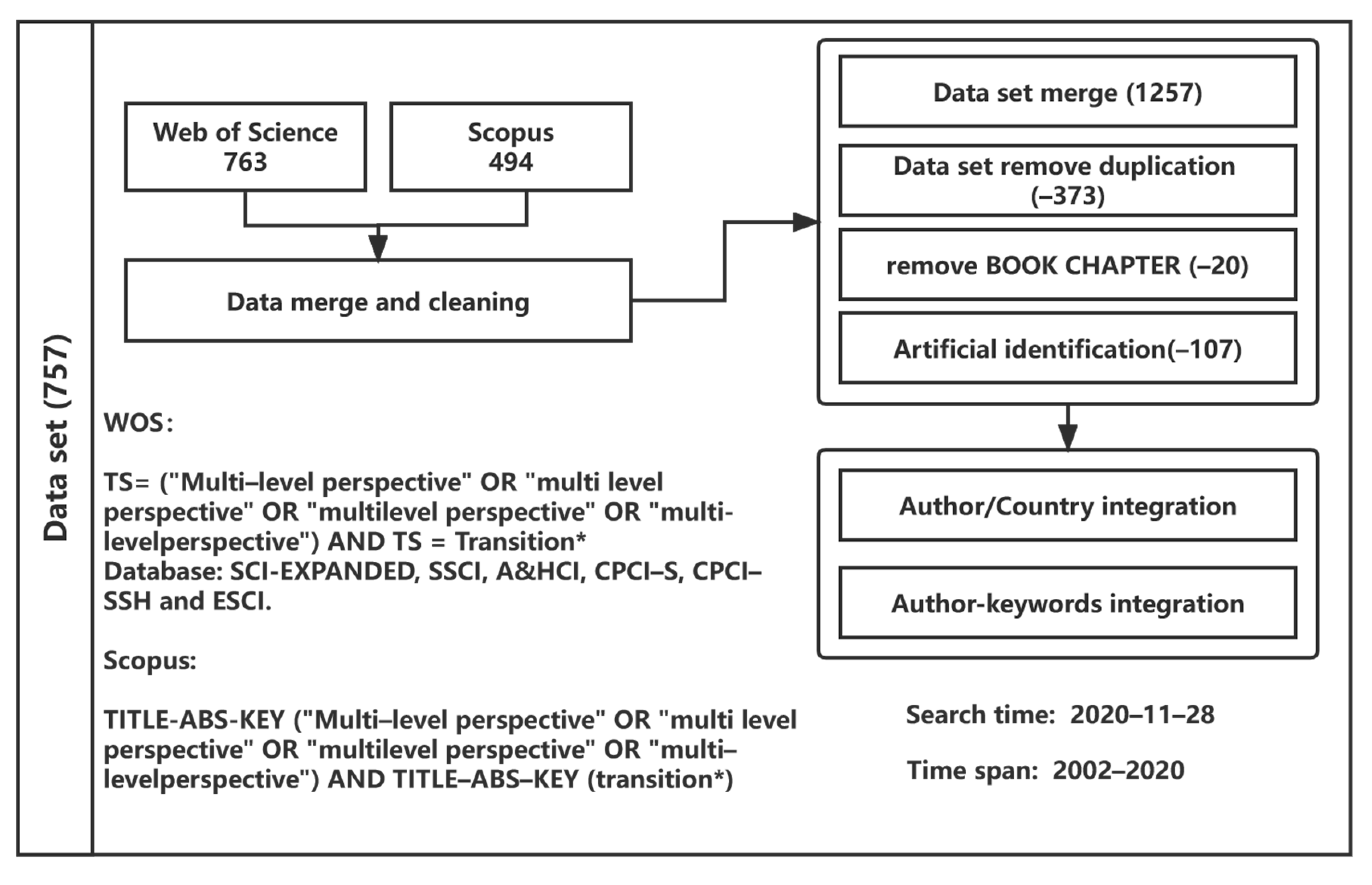

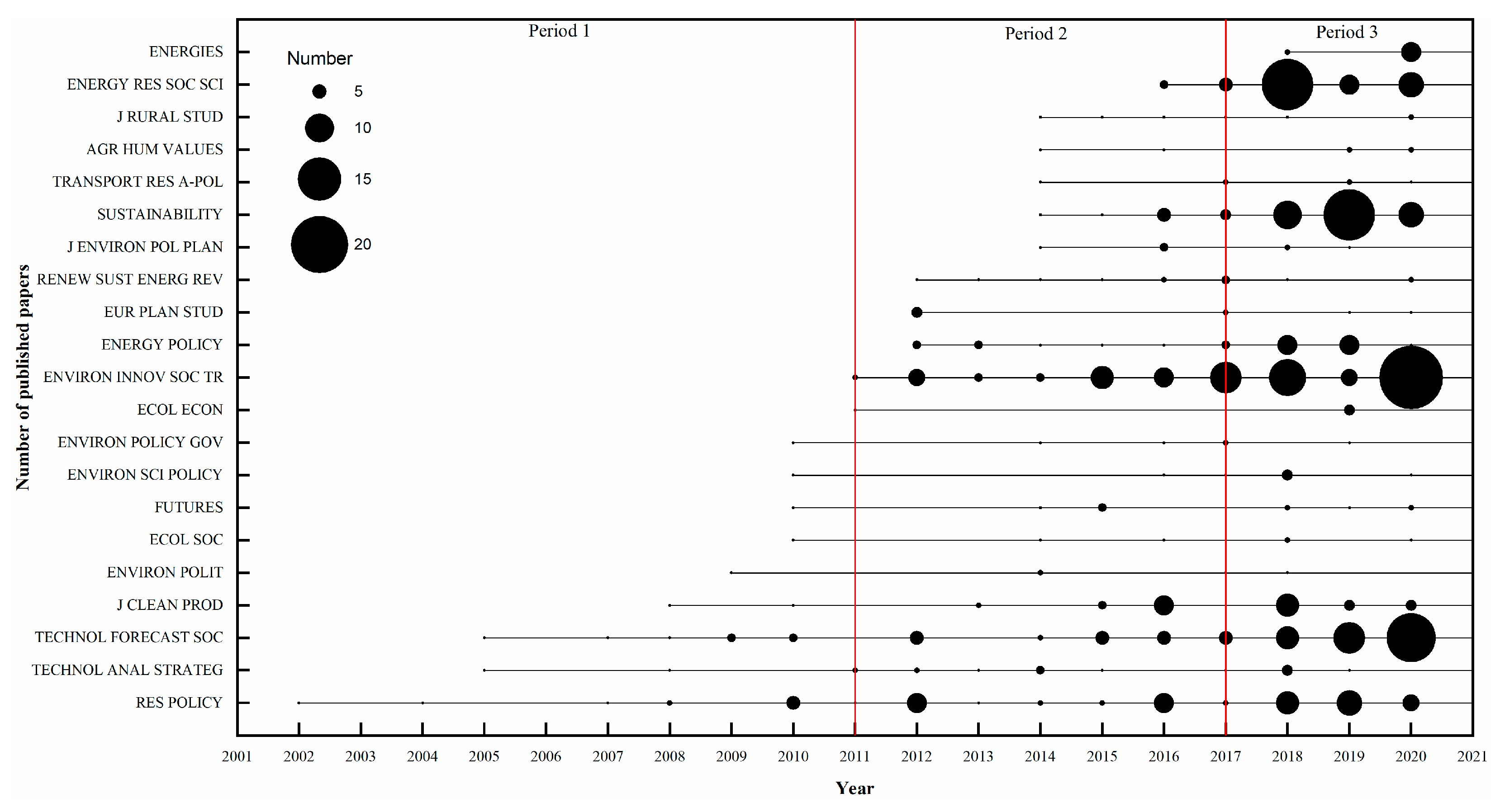

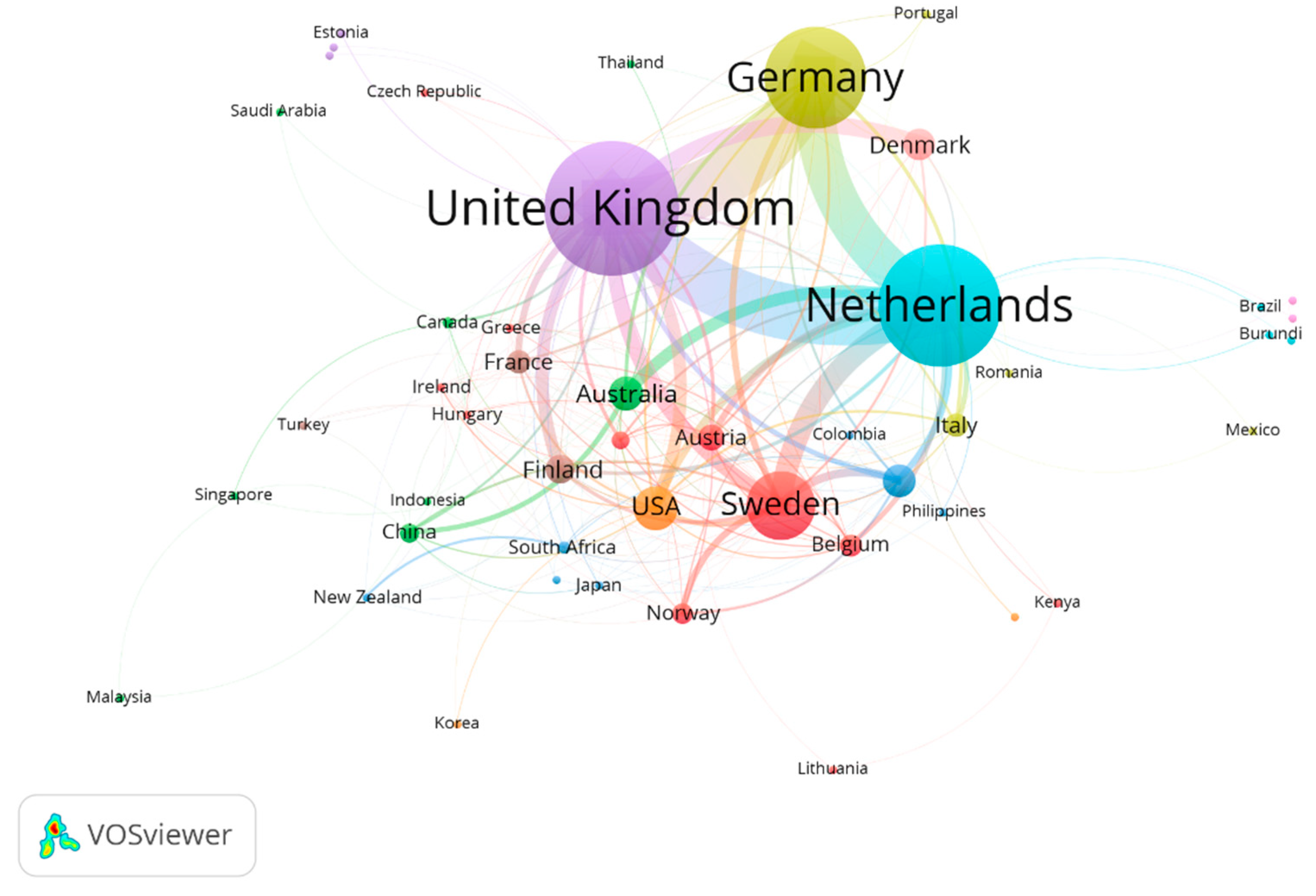

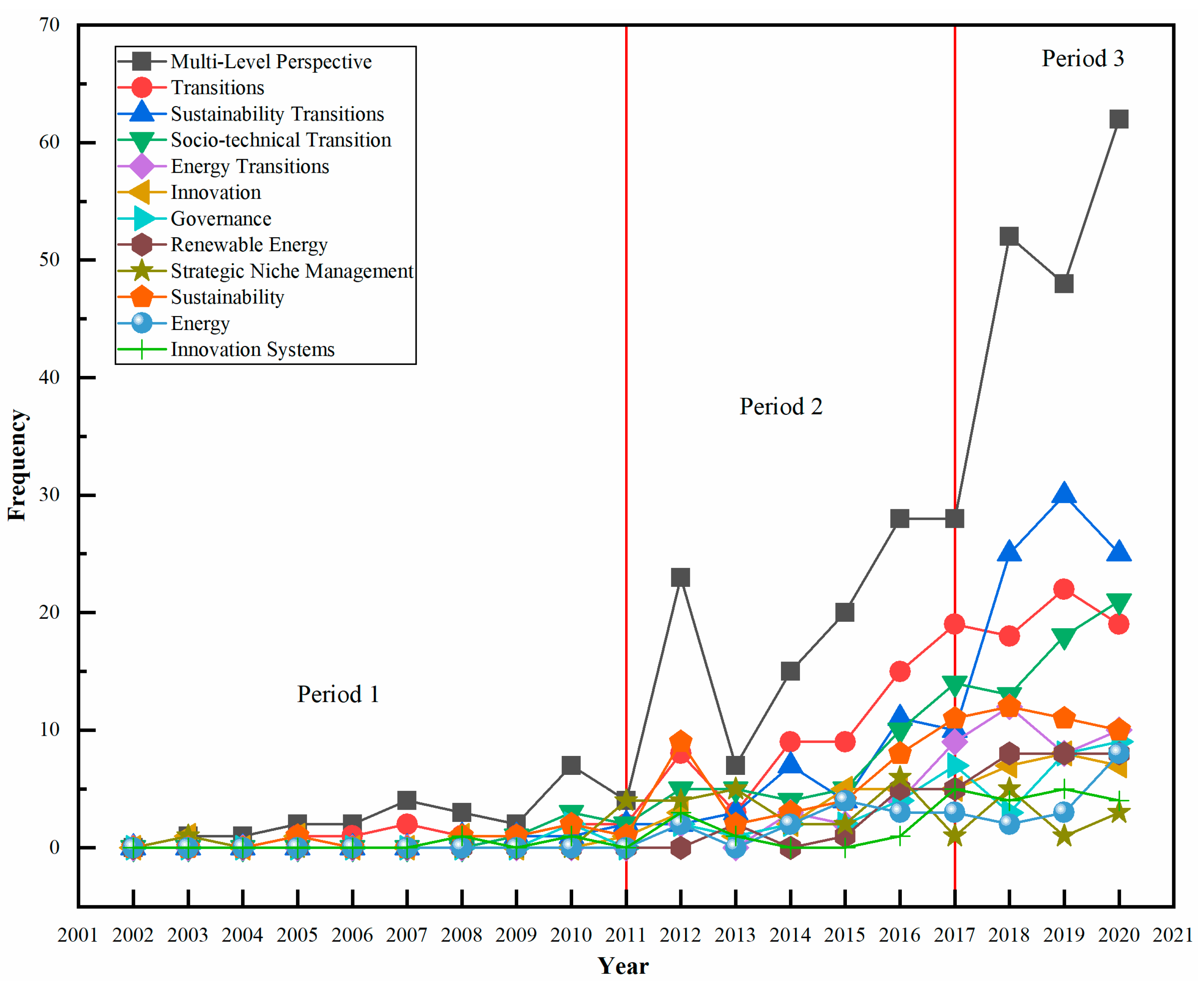

| Topic | Period 1 | Period 2 | Period 3 | Total | |
|---|---|---|---|---|---|
| Main Information | Documents | 55 | 310 | 392 | 757 |
| Sources | 28 | 129 | 134 | 233 | |
| Keywords Plus (ID) | 234 | 762 | 977 | 1507 | |
| Author’s Keywords (DE) | 202 | 993 | 1278 | 2115 | |
| Years | 10 | 6 | 3 | 19 | |
| Average citations per documents | 232 | 40.94 | 7.352 | 37.44 | |
| Authors | 83 | 642 | 948 | 1514 | |
| Author Appearances | 120 | 821 | 1173 | 2114 | |
| Documents per Author | 0.663 | 0.483 | 0.414 | 0.5 | |
| Authors per Document | 1.51 | 2.07 | 2.42 | 2 | |
| Co-Authors per Documents | 2.18 | 2.65 | 2.99 | 2.79 | |
| Collaboration Index | 2.08 | 2.38 | 2.76 | 2.31 | |
| References | 2570 | 15,432 | 22,951 | 37,773 | |
| Publications/year | 5.5 | 51.7 | 130.7 | 39.8 | |
Publisher’s Note: MDPI stays neutral with regard to jurisdictional claims in published maps and institutional affiliations. |
© 2022 by the authors. Licensee MDPI, Basel, Switzerland. This article is an open access article distributed under the terms and conditions of the Creative Commons Attribution (CC BY) license (https://creativecommons.org/licenses/by/4.0/).
Share and Cite
Wang, C.; Lv, T.; Cai, R.; Xu, J.; Wang, L. Bibliometric Analysis of Multi-Level Perspective on Sustainability Transition Research. Sustainability 2022, 14, 4145. https://doi.org/10.3390/su14074145
Wang C, Lv T, Cai R, Xu J, Wang L. Bibliometric Analysis of Multi-Level Perspective on Sustainability Transition Research. Sustainability. 2022; 14(7):4145. https://doi.org/10.3390/su14074145
Chicago/Turabian StyleWang, Cheng, Tao Lv, Rongjiang Cai, Jianfeng Xu, and Liya Wang. 2022. "Bibliometric Analysis of Multi-Level Perspective on Sustainability Transition Research" Sustainability 14, no. 7: 4145. https://doi.org/10.3390/su14074145
APA StyleWang, C., Lv, T., Cai, R., Xu, J., & Wang, L. (2022). Bibliometric Analysis of Multi-Level Perspective on Sustainability Transition Research. Sustainability, 14(7), 4145. https://doi.org/10.3390/su14074145






